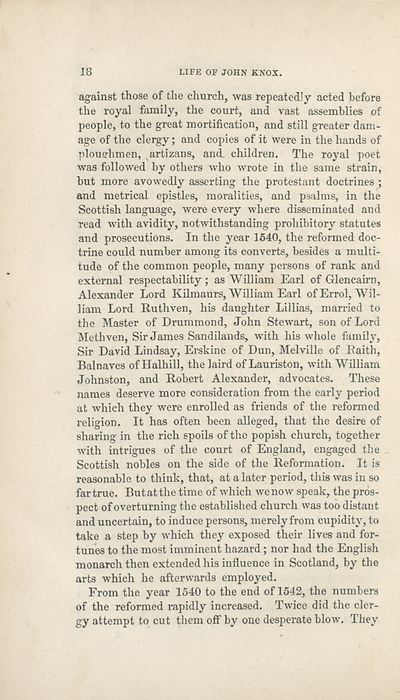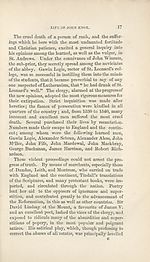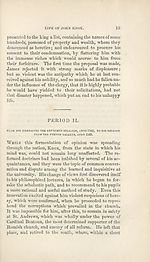Download files
Complete book:
Individual page:
Thumbnail gallery: Grid view | List view

18
LIFE OF JOHN KNOX.
against those of the church, was repeatedly acted before
the royal family, the court, and vast assemblies of
people, to the great mortification, and still greater dam¬
age of the clergy; and copies of it were in the hands of
plouehmen, artizans, and. children. The royal poet
was followed by others who wrote in the same strain,
but more avowedly asserting the protestant doctrines ;
and metrical epistles, moralities, and psalms, in the
Scottish language, were every where disseminated and
read with avidity, notwithstanding prohibitory statutes
and prosecutions. In the year 1540, the reformed doc¬
trine could number among its converts, besides a multi¬
tude of the common people, many persons of rank and
external respectability; as William Earl of Glencairn,
Alexander Lord Kilmaurs, William Earl of Errol, Wil¬
liam Lord Ruthven, his daughter Lillias, married to
the Master of Drummond, John Stewart, son of Lord
Methven, Sir James Sandilands, with his whole family,
Sir David Lindsay, Erskine of Dun, Melville of Eaith,
Balnaves of Halhill, the laird of Lauriston, with William
Johnston, and Robert Alexander, advocates. These
names deserve more consideration from the early period
at which they were enrolled as friends of the reformed
religion. It has often been alleged, that the desire of
sharing in the rich spoils of the popish church, together
with intrigues of the court of England, engaged the
Scottish nobles on the side of the Reformation. It is
reasonable to think, that, at a later period, this was in so
far true. Butatthe time of which we now speak, the pros¬
pect of overturning the established church was too distant
and uncertain, to induce persons, merely from cupidity, to
take a step by which they exposed their lives and for¬
tunes to the most imminent hazard; nor had the English
monarch then extended his influence in Scotland, by the
arts which he afterwards employed.
From the year 1540 to the end of 1542, the numbers
of the reformed rapidly increased. Twice did the cler¬
gy attempt to cut them off- by one desperate blow. They
LIFE OF JOHN KNOX.
against those of the church, was repeatedly acted before
the royal family, the court, and vast assemblies of
people, to the great mortification, and still greater dam¬
age of the clergy; and copies of it were in the hands of
plouehmen, artizans, and. children. The royal poet
was followed by others who wrote in the same strain,
but more avowedly asserting the protestant doctrines ;
and metrical epistles, moralities, and psalms, in the
Scottish language, were every where disseminated and
read with avidity, notwithstanding prohibitory statutes
and prosecutions. In the year 1540, the reformed doc¬
trine could number among its converts, besides a multi¬
tude of the common people, many persons of rank and
external respectability; as William Earl of Glencairn,
Alexander Lord Kilmaurs, William Earl of Errol, Wil¬
liam Lord Ruthven, his daughter Lillias, married to
the Master of Drummond, John Stewart, son of Lord
Methven, Sir James Sandilands, with his whole family,
Sir David Lindsay, Erskine of Dun, Melville of Eaith,
Balnaves of Halhill, the laird of Lauriston, with William
Johnston, and Robert Alexander, advocates. These
names deserve more consideration from the early period
at which they were enrolled as friends of the reformed
religion. It has often been alleged, that the desire of
sharing in the rich spoils of the popish church, together
with intrigues of the court of England, engaged the
Scottish nobles on the side of the Reformation. It is
reasonable to think, that, at a later period, this was in so
far true. Butatthe time of which we now speak, the pros¬
pect of overturning the established church was too distant
and uncertain, to induce persons, merely from cupidity, to
take a step by which they exposed their lives and for¬
tunes to the most imminent hazard; nor had the English
monarch then extended his influence in Scotland, by the
arts which he afterwards employed.
From the year 1540 to the end of 1542, the numbers
of the reformed rapidly increased. Twice did the cler¬
gy attempt to cut them off- by one desperate blow. They
Set display mode to:
![]() Universal Viewer |
Universal Viewer | ![]() Mirador |
Large image | Transcription
Mirador |
Large image | Transcription
| Antiquarian books of Scotland > Scotland/Scots > Life of John Knox ; and, The life of Alexander Henderson > (36) |
|---|
| Permanent URL | https://digital.nls.uk/131832736 |
|---|
| Description | Thousands of printed books from the Antiquarian Books of Scotland collection which dates from 1641 to the 1980s. The collection consists of 14,800 books which were published in Scotland or have a Scottish connection, e.g. through the author, printer or owner. Subjects covered include sport, education, diseases, adventure, occupations, Jacobites, politics and religion. Among the 29 languages represented are English, Gaelic, Italian, French, Russian and Swedish. |
|---|

